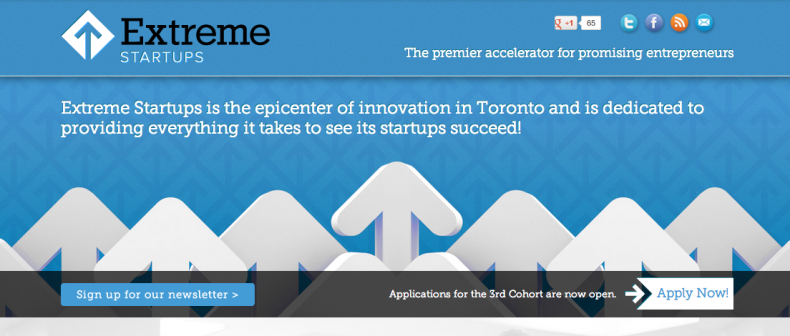
Several weeks ago, Toronto-based start-up accelerator Extreme Startups hosted its semi-annual Demo Day. During the event, the accelerator’s current crop of startups were given the opportunity to pitch a group of assembled investors and media on their business idea and product. Several months of non-stop hard work culminated in an anxious moment as five companies and their founders had about ten minutes to capture the imagination – and cash – of the people who would ultimately help make their companies successes or failures. Watching those entrepreneurs share their ideas, I gained insight into what makes a pitch good or bad. Here’s what I learned.
Focus on the solution, not the problem
On a basic level, most startups develop a product that utilizes a new or existing technology to solve a problem consumers have. It’s for this reason that these companies spend so much of their time trying to convince consumers that there’s a problem in their life that needs fixing. Now, while it’s important to do that, it’s also critical not to overstate the problem. Instead, focus on your company’s solution, and how your solution is different and elegant.
On Demo Day, the company that identified a significant and important problem to solve also left me wondering how they were going to go about solving it. Kera (website pictured above) is an in-app and online learning platform. Max Cameron and his team have found a noble problem to attempt to resolve – that is, how to make learning to use a website or application easier and more intuitive – but beyond using some embedded videos, I have no idea what makes the company’s solution different to its predecessors or what is currently available on the market. A subsequent visit to the company’s website has clarified how the company will making using a website easier, but not how they intend to make using desktop and mobile apps easier to learn.
This is a problem. In the startup world, there are often multiple companies working at the same time to resolve an issue. The solution is what a company has control over, and both customers and investors will gravitate to a solution that is elegant, simple, and effective.
Analytics are great, but ensure that your pitch strikes an emotional chord too
One of the highlights of the event was a surprise presentation by Wayne Chang of Crashlytics. Chang used his presentation as an opportunity to talk about the importance of what he called “engineering emotion.” Engineering emotion might seem a cynical phrase, but all Chang meant by it was that companies should try to create relationships with customers that go beyond simple happiness or anger toward a product.
To illustrate his point, he used examples of how his company interacts with its customer base. So, for instance, clicking on the pricing tab on the Crashlytics webpage will lead to a page where the visitor is invited to claim a free invite to the company’s software, which, in this case, looks like an old movie ticket (pictured above). It’s this kind of playfulness that permeates almost every interaction Crashlytics has with its customers, and it’s that kind of approach that has made the company widely popular with its clients and peers. For our purposes, however, I think Chang’s presentation demonstrated something most start-ups, and even mature companies, miss: Often times, an emotional appeal is more powerful in selling someone on an idea or product than a rational one is. In fact, the best pitches throughout the day made sure to establish the emotional stakes early on and reiterate them throughout.
In that respect, one of the more effective presentations of the day was delivered by Steve Cosman of MyShoebox. Cosman’s company is a cloud-based photo backup service and, as avid amateur photographer, I’m well acquainted with MyShoebox’s competitors. However, what made Cosman’s pitch click instantly with me was the emotional appeal he made at the start of his presentation.
Using Powerpoint (slide pictured below), Cosman brought up a picture of all the digital devices he’s used to either take a picture or store one. As he listed off all the DSLRs, laptops, external hard drives, and tablets he’s owned over the years, he admitted that, despite all that technology, he doesn’t have any of the pictures he took during his honeymoon. At that point, at least for me, he didn’t have to say anything else; I was sold. Of course, this is not to say that his presentation did not include relevant information for investors – it did. Ultimately, however, what made his presentation so effective was that it balanced both emotional and rational spheres – there was, as it were, something there for everyone.
The Stevenote is a great example of tech presentation done right, but it’s also not the only example
Having watched several Apple keynotes during Steve Jobs’ second stint at the company, I was struck by how many Jobs impersonations I had just witnessed at Demo Day. In fact, were it not for a missing utterance of “one more thing,” I might have been convinced resurrections were possible.
Jobs was a superb public speaker and his presentation style remains a paradigm, especially in the tech world. That said, his brashness could also be grating; one visit to TED should convince anyone that are a variety of ways to make complex ideas approachable to non-experts.
With that said, it’s important to develop and hone a presentation style that is specific to the individual delivering the presentation. After all, the aspect of a presentation that will resonate with anyone – investors included – is a comfort in one’s own skin and confidence, and that is something that is infectious.
This, moreover, underscores an even more important point: one, if he were still alive, I think even Jobs himself would advocate – be different.
Almost every start-up at the event presented a solution that several other competitors are working on at the same time. For that reason, it’s important to remember that in the fickle world of tech-startups, it’s not always the “best” product or company that wins; something as simple as a different presentation style might mean the difference between securing enough funding to create the next tech giant or seeing a young company go up in flames.
____
Igor Bonifacic is a writer working for the Toronto Standard. You can follow him on twitter @igorbonifacic.
For more, follow us on Twitter @TorontoStandard and subscribe to our newsletter.














